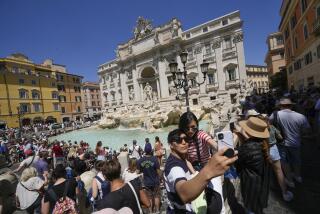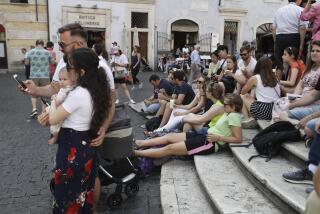Stretching the dollar across the Atlantic
- Share via
Big BEN keeps telling time, the Eiffel Tower sparkles with colored lights every night, and Europe is still the most popular destination for Americans going abroad, according to the U.S. Department of Commerce.
One important factor, however, has changed: the price.
As of mid-January, 1 euro cost about $1.30 — 55% more than in September 2002, when you could buy a euro for a record low of 84 cents. One British pound now costs about $1.85 — a 28.5% increase over three years ago.
More than the fear of terrorism, hassles at airports and anti-American sentiment over the war in Iraq, the diminished buying power of the dollar is discouraging travel to Europe in 2005.
Some economists predict it will keep sliding, possibly bottoming out at $1.40 to a euro before the year is out.
So, while Europeans stream to the U.S., where their money goes far, Americans have to think long and hard before buying a plane ticket across the pond and booking a room in one of the more expensive European capitals.
“I remember when $50 for a double room was the absolute maximum for a listing in one of my guidebooks,” said Rick Steves, author of “Europe Through the Back Door.” “Today, if I can find one for under $100, I’m pleased.”
Despite the bleak economics, there are indications that when Europe beckons, Americans will not be deterred. Tourism from the U.S. to Europe rose 20% last year, according to the European Travel Commission, a nonprofit agency with headquarters in Brussels, and no slowdown has occurred so far this year.
American tour companies such as Maupintour and Globus-Cosmos report banner bookings in some categories this year, and Ray Lampard, co-founder of RothRay, a vacation apartment rental firm in Paris that caters to Americans, said demand is at its strongest in 20 years.
Travelers intent on visiting Europe this year will have to swallow hard and pay more or lower their standards, booking rooms at moderately priced mom-and-pop hotels instead of the Ritz.
But a few good values — if not bargains — are still available. The European Travel Commission reported that airlines were cutting business-class fares to Europe by up to 75%, which means a seat at the front of the plane might be within reach.
Deluxe European cruises on high-end lines such as Crystal and Radisson Seven Seas look like a good buy to Priscilla Alexander, president and founder of Protravel International Inc., a New York-based agency that specializes in high-end and corporate travel.
“That’s where the value is,” she said. “The per-day price is comparable to the rate at a four- or five-star hotel in Italy, but food and transportation are included.”
Alexander predicted that travelers at the high and low ends would travel to Europe this year regardless of the plummeting dollar but that those in the middle might be put off. People seeking to spend $200 to $300 a day in Europe will need to adopt some of the dollar-stretching strategies long practiced by budget travelers.
*
Budget strategies
Now more than ever, it pays to plan, watch newspaper ads and check airline websites for low airfares and package deals. Locking in reasonable prices for big-ticket items such as transportation and accommodations helps take the sting out of daily expenses in Europe, where the cost of incidentals — coffee, city maps, taxis — makes you feel as if you have a hole in your pocket.Three general strategies can help make Europe more affordable this year:
Travel off-peak: From October to April, airfares and hotel rates fall to a fraction of what they are the rest of the year.
Europe in the off-season may have its discomforts, but it is high season for the performing arts, crowds are smaller at tourist attractions, merchants have more time to help customers, and the hard-sell atmosphere dissipates, making travelers feel more like locals.
Pack for harsh weather, although the travel gods may surprise you. Earlier this month, Paris was 50 degrees and sunny.
Consider tours and packages: Tour companies, which buy early, in bulk and at wholesale rates, pass on some of the savings to clients in package deals.
Robert E. Whitley, president of the New York-based U.S. Tour Operators Assn., estimated that booking a tour or package could cut costs by as much as 40%. But he noted that although some operators guarantee the advance price, others have tacked on surcharges to make up for losses resulting from the weak dollar.
Globus and Cosmo, longtime leaders in budget vacations to Europe, offer 58 tour programs, including an 11-day “European Introduction,” starting at less than $100 a day. For those disinclined to tour with a group, modestly priced packages including air, hotel and transfers abound, such as Maupintour’s “Express Vacations.”
Choose alternate destinations: Major capitals beloved by tourists — London, Paris, Rome — are among the priciest places in Europe, and that makes it hard for first-timers to take a grand tour.
But for those who already have visited Westminster Cathedral and walked along the Champs-Élysées, there are more affordable destinations in countries that have not yet adopted the euro, such as Poland, Romania, Hungary and the Baltic states of Estonia, Latvia and Lithuania.
Rates at Leading Hotels of the World properties reflect the price disparity. Doubles at Le Royal Meridien Bristol in Warsaw and the Kempinski Hotel Corvinus in Budapest, Hungary, cost about half as much as those at the Hôtel Meurice in Paris and the Dorchester in London.
“Any prudent traveler will make the value of the dollar a factor in choosing destinations,” said Rob Sangster, author of “Traveler’s Tool Kit: How to Travel Absolutely Anywhere!”
Look for deals: Beyond the three basic approaches, trimming costs may be in the details. Budget travel expert Steves suggested looking for weekend deals at business hotels. Barbara A. Gallay, president of the New York-based agency Linden Travel Bureau Inc., advised making use of visitor passes for transportation and attractions. The Stockholm Card, for instance, includes entrance to 70 attractions and use of the city’s mass-transit system for $26 a day.
Travelers also can save money by eating their big meal at lunch, flying in Europe on budget airlines such as Easyjet and paying close attention to transfers between airports and city centers. A cab from Heathrow to central London costs $50 to $80; the Tube’s Piccadilly line does the same job for less than $10.
Big Ben and the Eiffel Tower are still within reach — even if, in 2005, you have to stretch a bit more to get there.
More to Read
Sign up for The Wild
We’ll help you find the best places to hike, bike and run, as well as the perfect silent spots for meditation and yoga.
You may occasionally receive promotional content from the Los Angeles Times.






